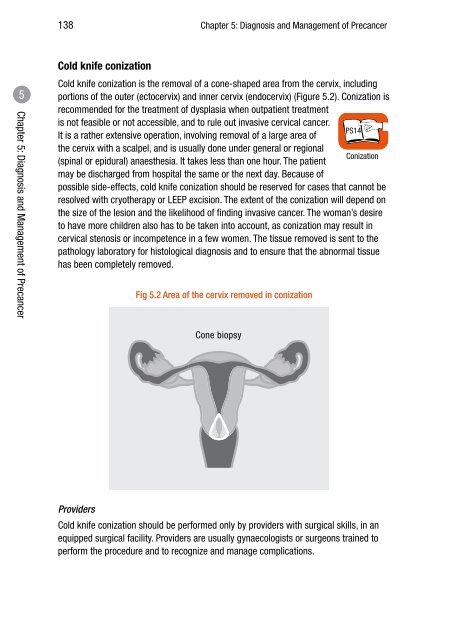CHAPTER 4: SCREENING FOR CERVICAL CANCER
CHAPTER 4: SCREENING FOR CERVICAL CANCER
CHAPTER 4: SCREENING FOR CERVICAL CANCER
You also want an ePaper? Increase the reach of your titles
YUMPU automatically turns print PDFs into web optimized ePapers that Google loves.
138 Chapter 5: Diagnosis and Management of Precancer5Chapter 5: Diagnosis and Management of PrecancerCold knife conizationCold knife conization is the removal of a cone-shaped area from the cervix, includingportions of the outer (ectocervix) and inner cervix (endocervix) (Figure 5.2). Conization isrecommended for the treatment of dysplasia when outpatient treatmentis not feasible or not accessible, and to rule out invasive cervical cancer.PS14It is a rather extensive operation, involving removal of a large area ofthe cervix with a scalpel, and is usually done under general or regionalConization(spinal or epidural) anaesthesia. It takes less than one hour. The patientmay be discharged from hospital the same or the next day. Because ofpossible side-effects, cold knife conization should be reserved for cases that cannot beresolved with cryotherapy or LEEP excision. The extent of the conization will depend onthe size of the lesion and the likelihood of finding invasive cancer. The woman’s desireto have more children also has to be taken into account, as conization may result incervical stenosis or incompetence in a few women. The tissue removed is sent to thepathology laboratory for histological diagnosis and to ensure that the abnormal tissuehas been completely removed.Fig 5.2 Area of the cervix removed in conizationCone biopsyProvidersCold knife conization should be performed only by providers with surgical skills, in anequipped surgical facility. Providers are usually gynaecologists or surgeons trained toperform the procedure and to recognize and manage complications.
















